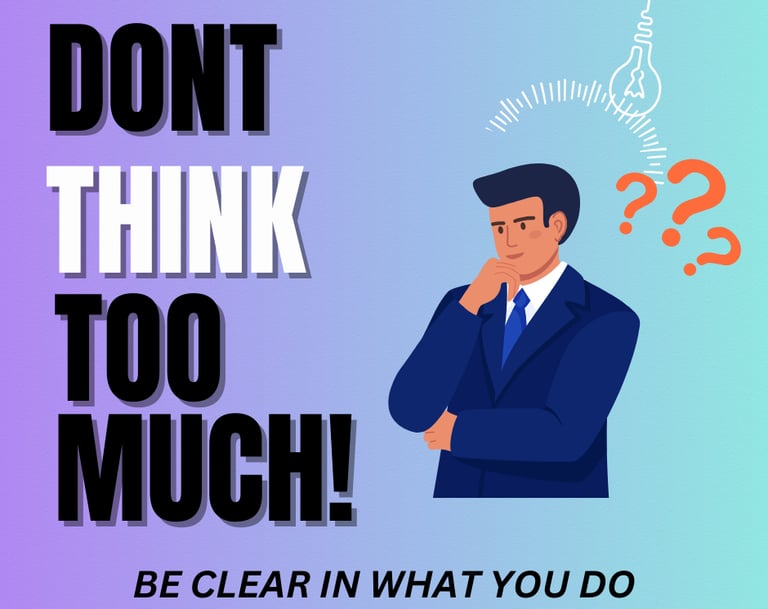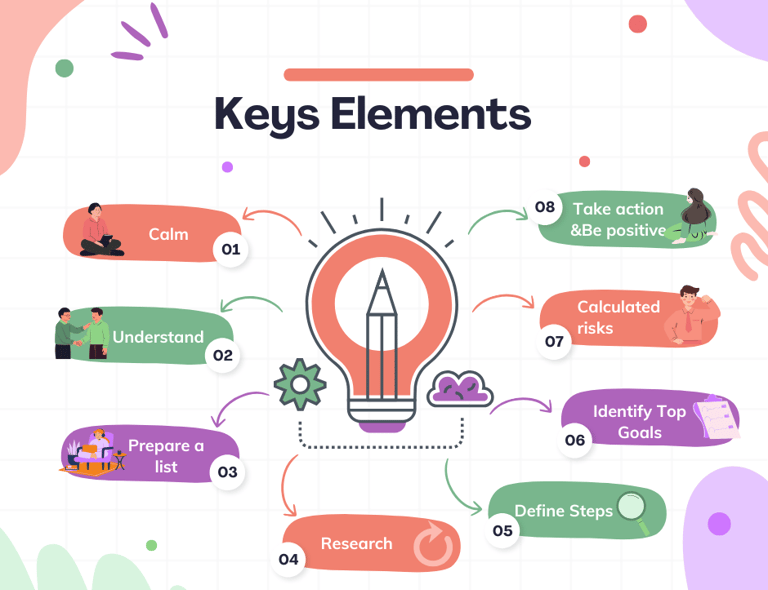The Power of Clarity: How It Eliminates Doubt and Provides Clear Answers for Clients
The more clear you are the more Business you can make
3/9/20254 min read


In a world overflowing with information, options, and competing voices, clarity plays a pivotal role in trust and understanding. Whether you're a business, a coach, a consultant, or a service provider, the ability to provide clarity to your clients is one of the most powerful tools you can wield. Clarity doesn’t just answer questions—it removes doubt, builds confidence, and fosters long-term relationships. But what exactly is clarity, and how does it work its magic? Let’s dive in
What is Clarity?
Clarity is about making things simple and easy to understand. It’s about taking complex ideas, processes, or information and presenting them in a way that feels straightforward and actionable. Think of it like turning on a light in a dark room—it helps your clients see what’s in front of them and navigate their way forward without Confusion.
When you provide clarity, you’re not just giving answers—you’re giving the right answers in a way that makes sense to your client. This builds trust, reduces stress, and helps them feel more in control.
The Significance of Clarity in Client Communication
It Solves Problems Quickly
Clients often come to you feeling overwhelmed. They might be unsure about what they need, how a process works, or what steps to take next. Clarity helps you cut through the confusion and give them straightforward answers. For example, if you’re a business coach, breaking down a complicated strategy into simple steps can help your client take action without feeling stuck.It Builds Trust and Confidence
When you’re clear and honest with your clients, they feel more confident in your expertise. They trust that you have their best interests at heart and that you’re guiding them in the right direction. This trust is the foundation of a strong, long-term relationship.It Removes Doubt and Fear
Doubt often comes from not knowing what to expect. When you provide clarity, you’re essentially saying, “Here’s what’s going to happen, and here’s how we’ll get there.” This reassurance helps clients feel more at ease and less afraid of making the wrong decision.
Strategies to Achieve Clarity in Communication
1. Utilize the BLUF (Bottom Line Up Front) Approach
BLUF" stands for "Bottom Line Up Front," which is a communication method where the key message or conclusion is presented at the very beginning of a document, conversation, or presentation, followed by supporting details; essentially, it means stating the most important information first to ensure the recipient quickly understands the core point. Why BLUF method involves presenting the main point at the beginning of the communication, because it allowing clients to grasp the essential information immediately.
2. Use the “Explain Like I’m 5” Method
Break down complex ideas into simple, relatable terms. Imagine you’re explaining something to a child—this forces you to avoid jargon and focus on the basics.
Example: If you’re a financial advisor, instead of saying, “We’ll diversify your portfolio to mitigate risk,” say, “We’ll spread your money across different types of investments so if one doesn’t do well, the others can balance it out.”
3. Create Step-by-Step Guides
Clients often feel overwhelmed when they don’t know what to expect. Provide a clear, step-by-step roadmap of the process so they know exactly what’s coming next.
Example: If you’re a wedding planner, give your clients a timeline that breaks down tasks like booking a venue, sending invitations, and choosing a caterer, with deadlines for each
4. Visualize the Information
Make them visualize how you have planned so far, make them imagine Sometimes, words aren’t enough. Use visuals like charts, diagrams, or infographics to make information easier to digest.
Example: If you’re a fitness coach, show a progress chart that tracks your client’s weight loss or strength gains over time. This helps them see their progress at a glance.
5. Kill the objections in advance
Put yourself in your client’s shoes and think about what questions they might have. Address these proactively in your communication, Make yourself ready in the position to handle the objections
Example: If you’re a Business Coach or Selling a Service, create a FAQ document that answers common questions like, “How long does it take to see growth in my business?” or “when should I expect to get more clients after working with you?”, "Are there any additional costs after this"?, Remember: After you client invested in you , they want results "ONLY" , they will not Patient like me , You should know how to handle that , Prepare , Prepare , Prepare
6. Be Transparent about you Challenges
Clients appreciate honesty. If there are limitations or potential challenges, be upfront about them and explain how you’ll address them.
Example: If you’re a Project, say, “This project might take little longer, we need to wait to do more testing, but we’ll keep you updated every step of the way.”
7. Provide Real-Life Examples
Show, don’t just tell. Use case studies, testimonials, or examples from past clients to illustrate how your process works and what results they can expect.
Example: If you’re a career coach, share a success story like, “One of my client landed their dream job after we worked on their resume and interview skills. Here’s how we did it.”
Final Thoughts: Clarity is Key
In a world full of noise and confusion, clarity is your superpower. It’s what helps your clients feel heard, understood, and confident in their decisions. By focusing on clear communication, you’re not just solving problems—you’re building trust, reducing stress, and creating happier clients.
Embracing clarity in communication is a continuous process that requires attention and dedication. Remember , Most of the time we lose the deal not just because our product or service is not good as we believe but we are not clear and even we don't make our client clear what will be the outcome , How we will deliver what we promised. And in the end, that’s what keeps clients coming back.


© 2024. All rights reserved.
Free Clarity Session
Feeling disconnected at work or in your personal life?
Not sure why conversations don’t flow the way you want?
I’m offering 30-minute clarity calls for anyone who just wants to talk, understand themselves better, and get a fresh perspective on their communication block
What we’ll talk about:
Specific problems you are facing
Why connecting feels difficult
2–3 simple things you can try right away
How it works:
Fill out the form
I’ll email you to confirm your slot
We meet on Zoom for 30 minutes
I’ll send you a short summary afterward
👉 Apply for a Free Session: https://docs.google.com/forms/d/e/1FAIpQLScUUaBGMNn6VngZXmknjS7RCnoPBsyqGJrmV4EYGTNoqL-fLg/viewform?usp=publish-editor
yashikabhatia51@gmail.com
A small note:
I’m not a therapist or certified coach. I just write about human behaviour and connection, and I genuinely enjoy helping people see things more clearly. This is simply a mindful conversation - Practical Advice
